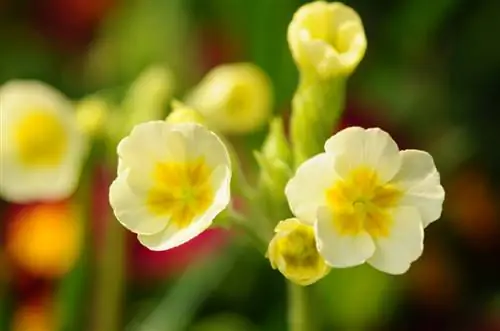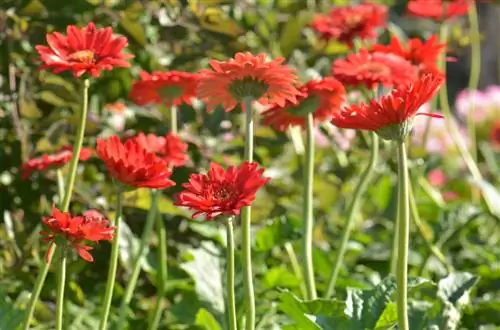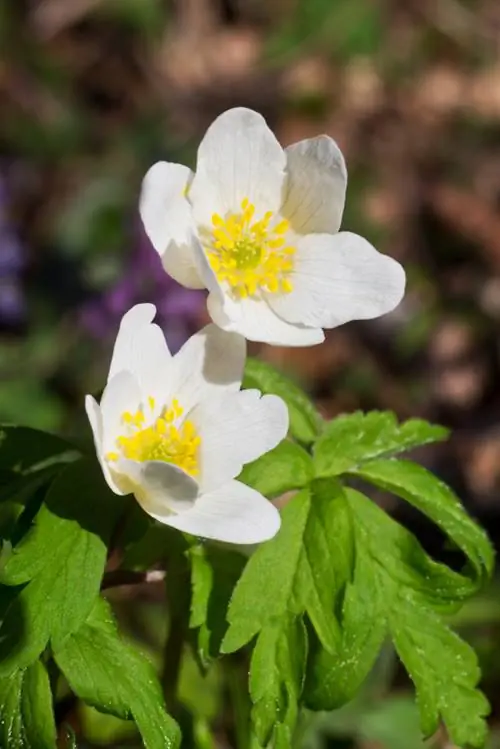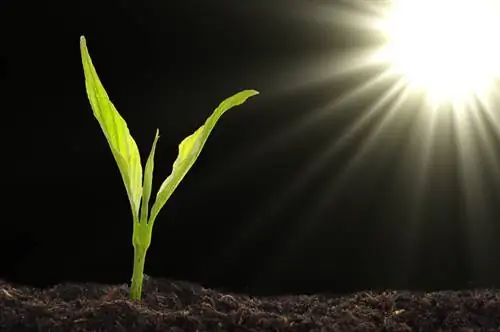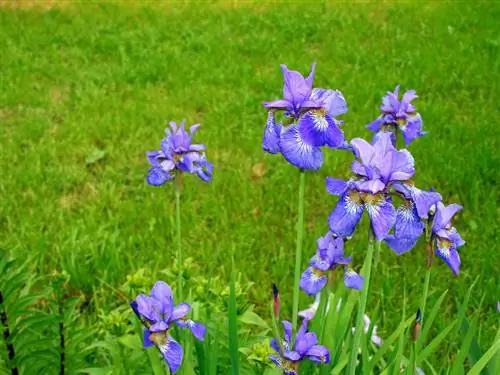- Author admin [email protected].
- Public 2023-12-25 17:45.
- Last modified 2025-01-23 11:22.
The cowslip impresses with its natural charm when it welcomes the spring sun from March. Chosen as Flower of the Year 2016, the Nature Conservation Foundation pays due respect to the distinctive forest and meadow perennial. If you still have questions about proper cultivation in the garden, you can get well-founded answers here.
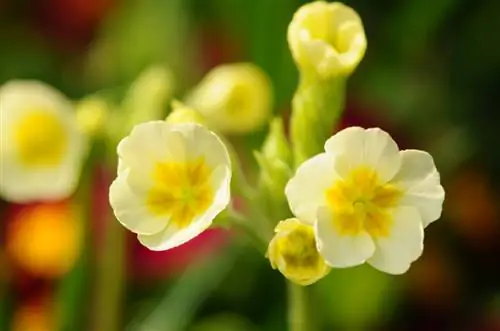
How do you care for a cowslip in the garden?
A cowslip requires little care: watering when it is dry, starting fertilization in March, occasional liquid fertilization during flowering, cutting off withered flower stalks and pruning close to the ground in late winter. Winter protection is not necessary for wild species, but is recommended for hybrids.
Planting the primrose correctly
Planting an early cowslip correctly does not require any extensive previous gardening knowledge. While you weed and rake the soil, place the still potted root ball in a container with water until no more air bubbles appear. The steps continue:
- Dig a pit twice the size of the root ball
- Enrich the excavation with compost, horn shavings, guano or bark humus
- Unpot the cowslip and plant it while maintaining the previous planting depth
Water the young plant with a generous sip of water. Ideally, you should arrange the natural perennial in a small group with 3 to 5 specimens, which underlines the picturesque effect.
Care tips
Caring for a cowslip poses no problems, even for hobby gardeners with limited time available. It's that easy:
- Water primroses when there is drought in summer and frost in winter
- Give starter fertilization to the bed in March
- Fertilize flowers in the pot every 2-3 weeks during the flowering period
- Cut off wilted flower stems at the base
- Pruning the fallen leaves close to the ground in late winter
If you cultivate wild species of cowslip, you don't have to worry about winter protection. Highly cultivated hybrids, on the other hand, are piled up 20-30 cm thick with leaves, straw and needle twigs. Potted flowers ideally move to bright, frost-free winter quarters.read more
Which location is suitable?
In the wild, the cowslip (Primula elatior) looks for a sunny to partially shaded spot in meadows or along a forest. Wherever the forest primrose finds humus-rich, calcareous and freshly moist soil, it likes to extend its roots. The cowslip (Primula veris), on the other hand, prefers a full sun to sunny location with sandy-loamy soil, like the rock garden has to offer. The closer the location in the garden is to these characteristics, the more at home the pretty perennials feel.read more
The correct planting distance
The cowslip rises its slender flower stem from a rosette of leaves. Depending on the species and variety, this can reach a width of up to 30 cm. It is this growth width that also defines the ideal planting distance. For example, the fragrant cowslip (Primula veris), which was named Flower of the Year 2016 by the Loki Schmidt Foundation, spreads between 20 and 30 cm, so a planting distance of 25 cm is a good choice. Although the primrose (Primula japonica) stretches up to 50 cm higher towards the sky, it has the same growth width, so that the appropriate planting distance here is also 25 cm.
What soil does the plant need?
Mother Nature has the right cowslip ready for almost every soil condition:
- High cowslip (Primula elatior): nutrient-rich, humus and fresh and moist
- Real cowslip (Primula veris): humus, sandy-loamy and rather dry
- Flower cowslip (Primula japonica): nutrient-rich, loamy, likes to be on the damp edge of the pond
The requirements for the moisture content of the soil may vary; Of course, cowslips cannot tolerate waterlogging.
What is the best time to plant?
The cowslip is planted all year round, as long as the ground is not frozen. If you are considering sowing directly in the bed, we recommend late summer as the seeds are cold germinators. In this way, Mother Nature does the stratification.
When is flowering time?
The specific species defines the flowering period of a cowslip. If you combine the signs of spring in coordination with their bloom, the blaze of color extends from March to September. The following arrangement shows a possible variant:
- High cowslip (Primula elatior): March to May
- Sky key (Primula veris): April to May
- Flower cowslip (Primula japonica): June to August
- Bell cowslip (Primula florindae): July to September
read more
Cut the primrose correctly
Cut off the withered flower stalks immediately if seed formation and the associated self-sowing of a cowslip is not desired. Otherwise, leave the flower in the bed until the foliage has completely shrunk. In late winter at the latest, the cowslip is cut back close to the ground to make room for the next growing season.
Watering primroses
Don't let cowslips dry out. If the natural rainfall does not cover the water requirement, watering is carried out regularly. The watering can is used more often in the bucket as soon as the substrate surface has dried. An exception is the cowslip, which also thrives in sandy, dry gravel beds. If summer is dry, water this perennial early in the morning, as the root ball must not dry out either.
Fertilize cowslip properly
In nutrient-rich soil, the cowslip does not require fertilizer. On the contrary, too much nitrogen could force foliage growth to the detriment of abundant flowers. In rather poor soil, we recommend starting fertilization in March with compost or liquid fertilizer.
You can fertilize a cowslip in a pot every 2-3 weeks from March until the end of the flowering period with liquid fertilizer (€9.00 on Amazon) for flowering plants or add long-term fertilizer in stick form to the substrate.
Wintering
Only the wild species are completely hardy. If you are cultivating one of the colorful hybrids from specialist retailers, they should be protected in the bed and put away in the pot before the first frost. How to do it right:
- Real and tall cowslip as a wild species can only be covered with leaves in rough locations
- Cover cultivated forms from the store in the bed with garden fleece or pile them up thickly with leaf mold, straw and needle twigs
Cowslips in the planter should be put away in the fall and the withered leaves cut off to prevent diseases and pests. The winter quarters are frost-free and bright. Water the root ball every now and then so that it does not dry out.
Propagate cowslips
The most uncomplicated method of propagation is through division in the fall. Dig up the cowslip over a wide area, shake off the soil and divide the root ball into two or more pieces. A suitable segment has at least 2 shoots. Plant a section at the new location without delay, while maintaining the previous planting depth if possible. Plenty of watering afterwards supports the cowslip in rooting.
Sowing also promises successful propagation. Collect the ripe capsule fruits after flowering and sow the seeds. The seedbed should be as finely crumbly as possible. Only sieve the seeds very thinly with sand or vermiculite, as they are light germinators, and water with a fine spray. If sowing takes place in autumn, the seeds receive the necessary cold stimulus over the winter and germinate in early spring.
How do I transplant correctly?
The cowslip accepts a change of location without complaint. Either in early spring or early fall, dig up the root ball and shake off the soil. Inspect the root system to cut out any dried or rotten strands. In the new place, plant the perennial just as deep in the soil, which is ideally enriched with compost.
Primrose in a pot
In the pot, cowslips spread a natural flair on the sunny to partially shaded balcony. The undemanding flower thrives in standard potting soil, which is given the desired permeability with a little sand or perlite. Drainage at the bottom of the pot above the water outlet prevents waterlogging. Check the substrate with a thumb test every 2 days and water when it is dry. As long as the cowslip is blooming, it receives a dose of liquid fertilizer every 2-3 weeks. Cut off the withered parts of the plant in autumn at the latest in order to move the cowslip to a bright, frost-free winter quarters. Even though the perennial is hardy, the root ball freezes in the open air in the exposed position of the pot and no longer produces flowers the next year.
How is the cowslip cared for after flowering?
The cowslip is so undemanding that no special care is required after flowering. If the withered flower stems affect the visual appearance, cut them off as well as the withered leaves. If the natural perennial is allowed to multiply on its own by sowing, leave the flower until the beginning of winter or early spring.
Is the cowslip protected?
Primroses have been under strict conservation protection since August 1980. You can admire and photograph the yellow natural beauties in fields, forests and meadows. Picking or even digging up, however, is punishable by high fines.read more
What healing properties does the cowslip have?
The traditional use of cowslips in natural medicine is experiencing a brilliant renaissance. It is primarily the secondary plant substances that make a Primula elatior or Primula veris so valuable. Essential oils, flavones, tannins and other substances relieve coughs, headaches, migraines and insomnia. How to make cowslip tea:
- Harvest the flowers between March and May
- Always collect the flowers including the calyx
- Pour boiling water over fresh or dried ones
- Let it steep for 10-20 minutes, add a little honey and enjoy
Since the cowslip is protected, it is best to grow the perennial in your own garden. Picking or digging in the wild is strictly prohibited and is punishable by heavy fines.
keyflower-medicinal herb
Beautiful varieties
- Fragrant cowslip: the flower of the year 2016 impresses with its yellow, wonderfully fragrant blossom; Growth height 10-20 cm
- High cowslip: the native species shows a closeness to nature with sulphur-yellow flowers; Growth height 15-25 cm
- Flower cowslip: scores with whorls of pink-red flowers in several tiers from June to August
- Bell Cowslip: charming yellow bell flowers and heart-shaped leaves from July to September; Growth height up to 70 cm
- Alba: white-flowering primrose for beds, balconies and edges of trees; Growth height 20-60 cm
- Amarant red: violet-red cushion cowslip for dense flower carpets from March; Growth height 15-20 cm
- Rose cowslip: red-flowering harbinger of spring for moist, sunny locations; Growth height 5-10 cm

